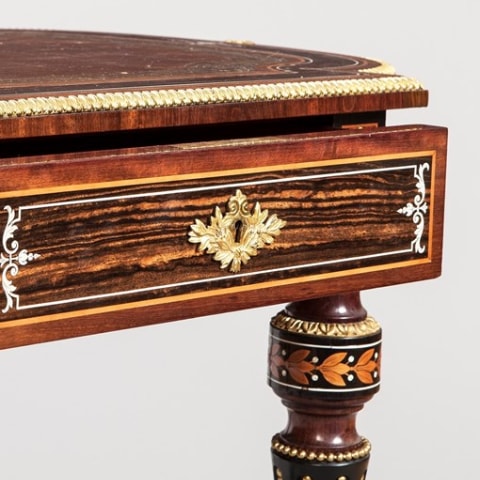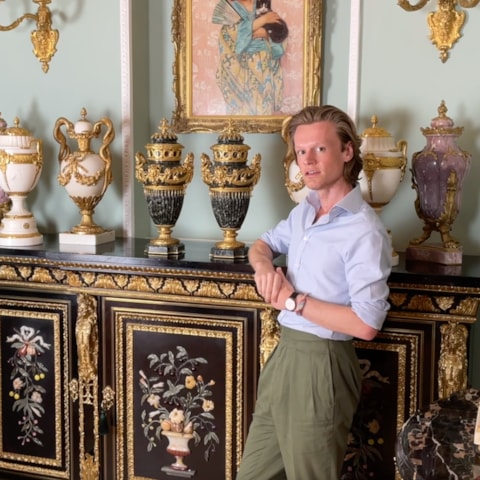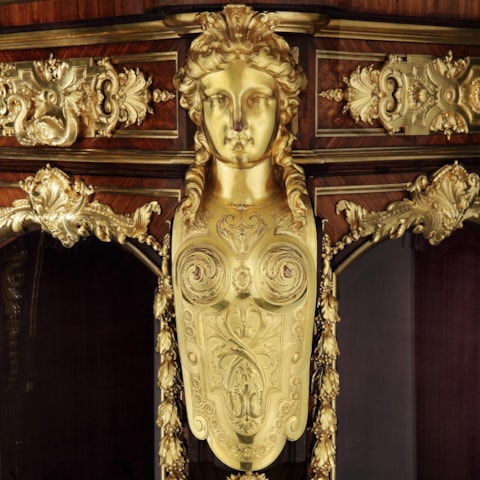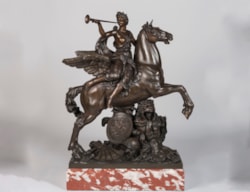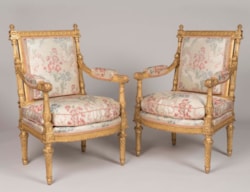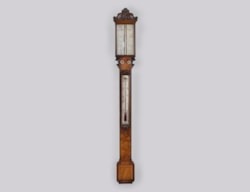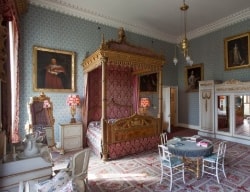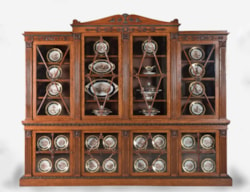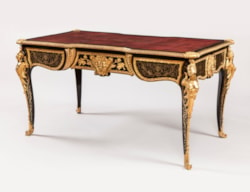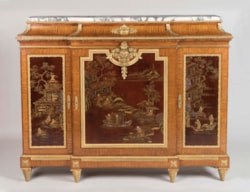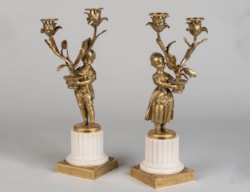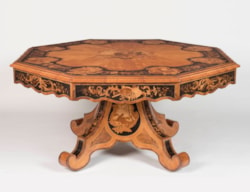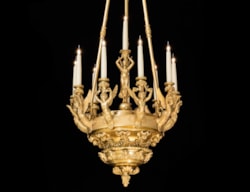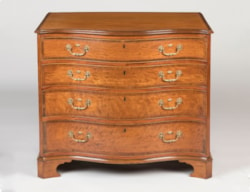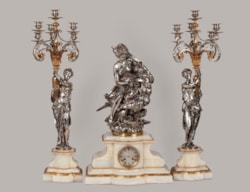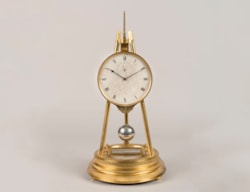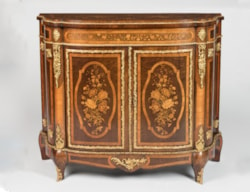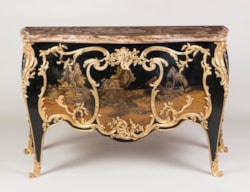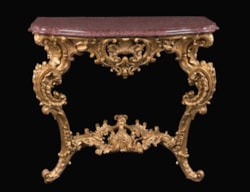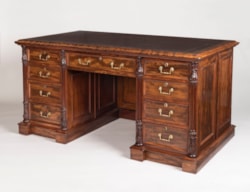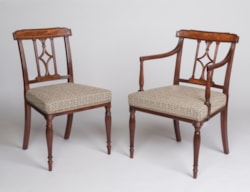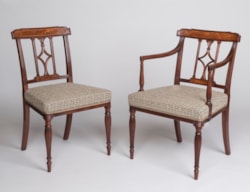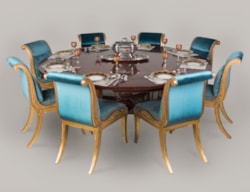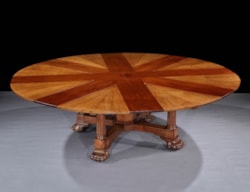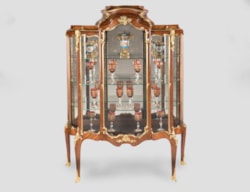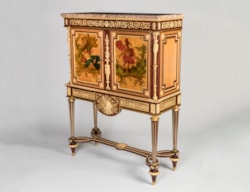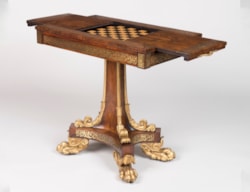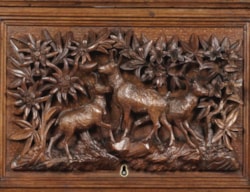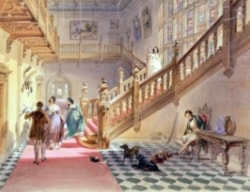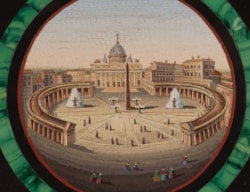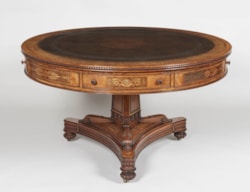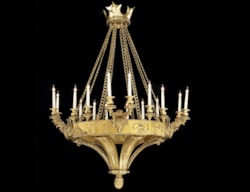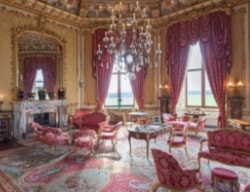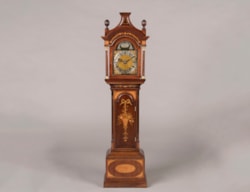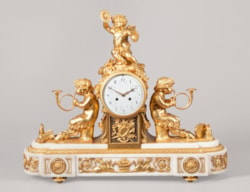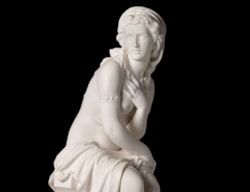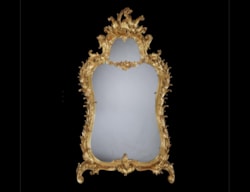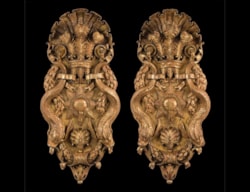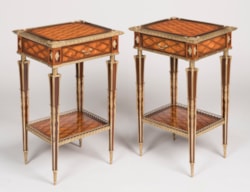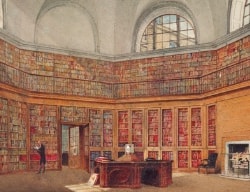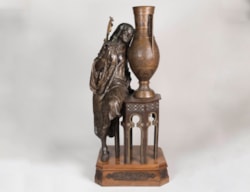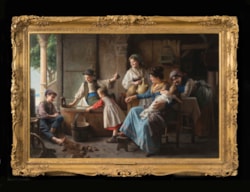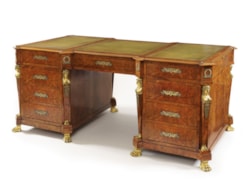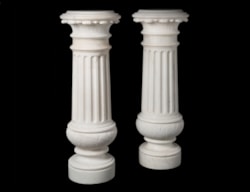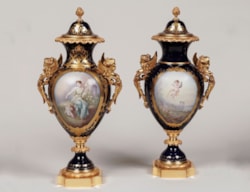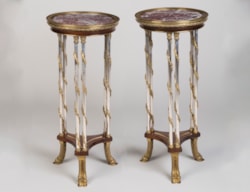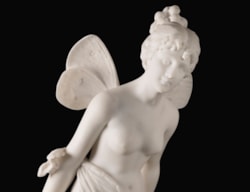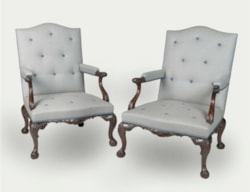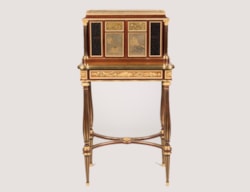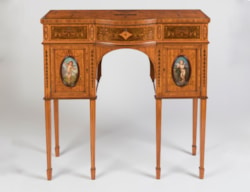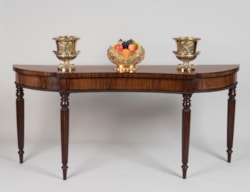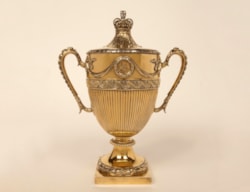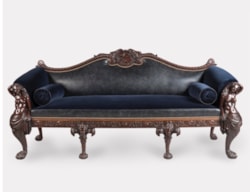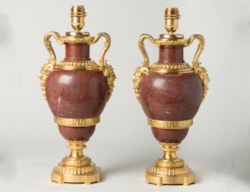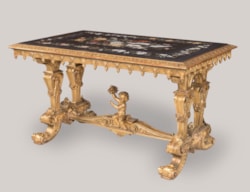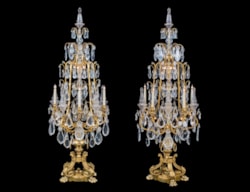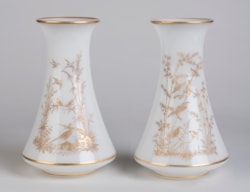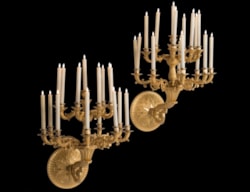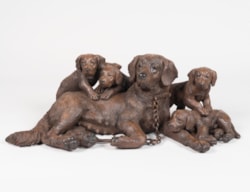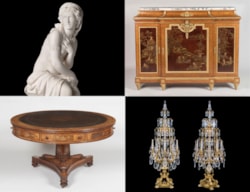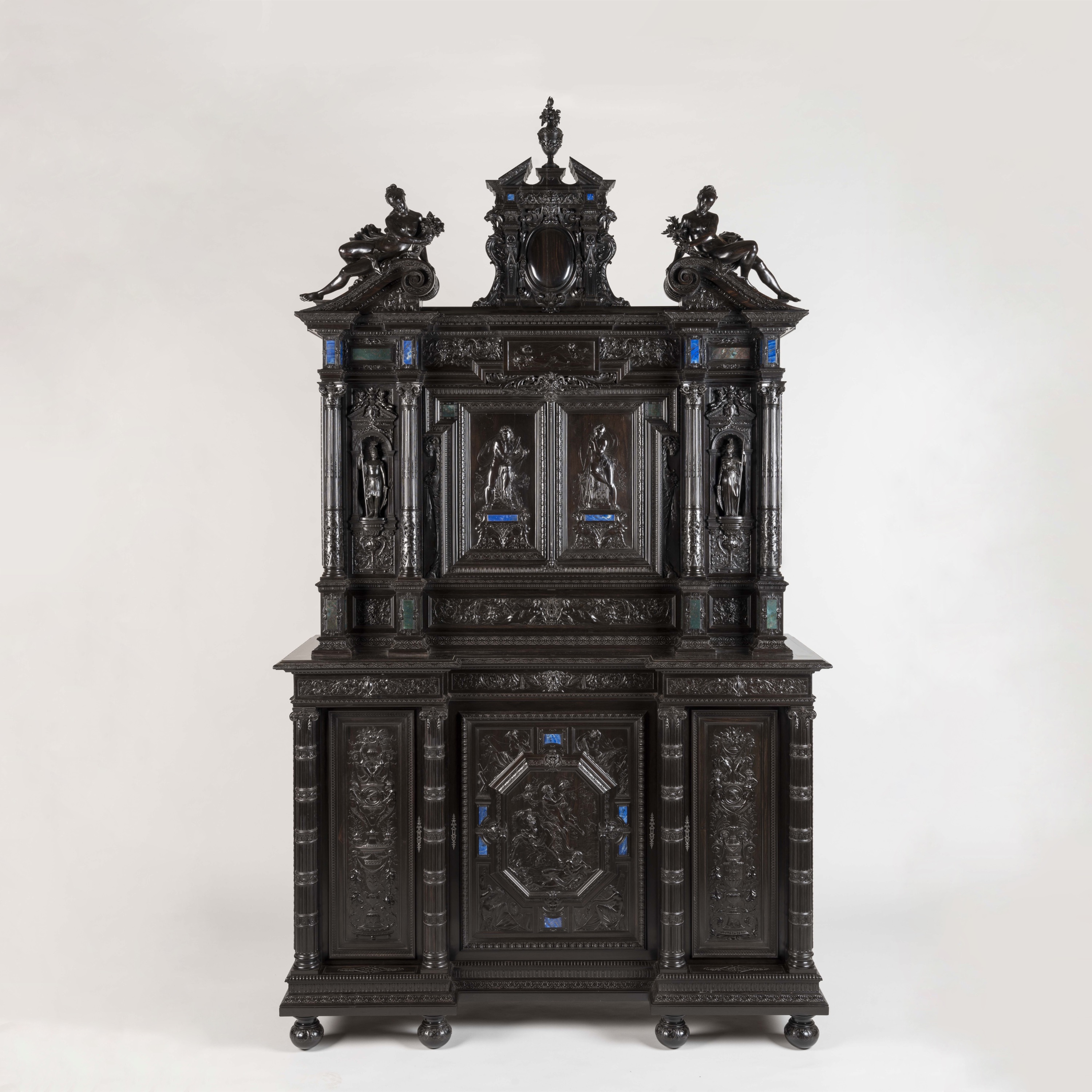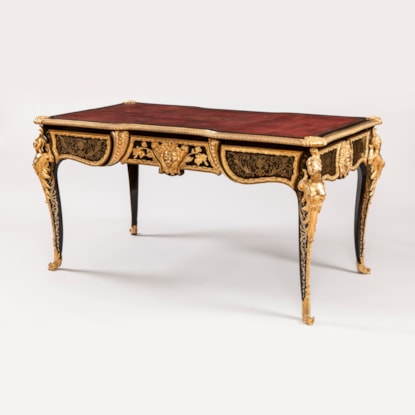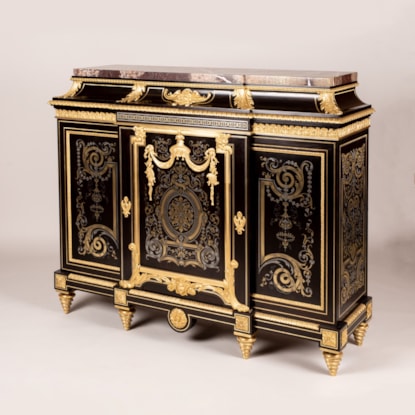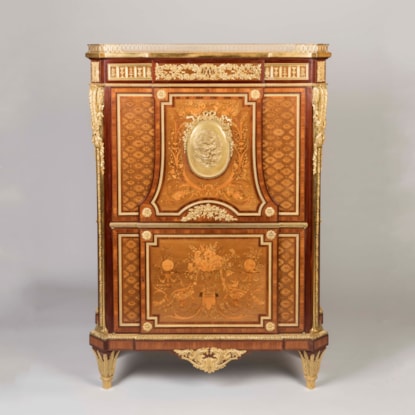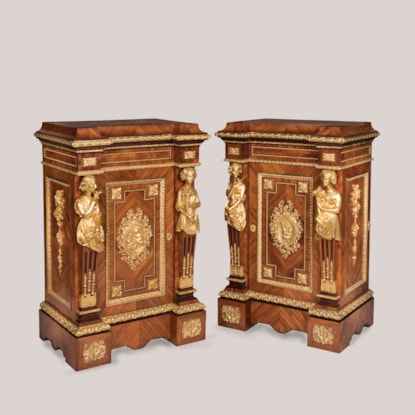Collection / Items of Distinction
The International Exhibition Carved Cabinet By Fourdinois of Paris
The International Exhibition Carved Cabinet By Fourdinois of Paris
Dimensions: H: 93.5 in / 237 cm | W: 58 in / 147 cm | D: 21.5 in / 54 cm
Sold
The International Exhibition Carved Cabinet
By Fourdinois of Paris
Presented at the 1862 World’s Fair in London
Sculpted by the workshop’s principal wood carver, Monsieur Megret, this unique and extraordinary ebony cabinet was repeatedly called a true masterpiece, “a work of the highest order,” and earned Fourdinois the Grand Medal for Excellence of Design & Manufacture.
This ebony cabinet, as much a sculpture as a piece of furniture, is a tribute to the art of the sixteenth century.
“Soberness of ornamentation, simplicity of line, precision of workmanship, are all present in the beautiful cabinet.” (International Jury of Class 30)
Standing nearly 8 feet tall, the inverted breakfront cabinet is enriched with incrustations of lapis lazuli, bloodstone and jasper, the interior front fittings relieved with the finest inlay of engraved ivory and delicately hand-chased silver masks. Supported on bun feet, the lower portion’s central panel with a very finely carved bas-relief of the Rape of Proserpine, the four angles filled in with allegories of the Arts & Sciences flanked by side panels carved with arabesque reliefs in the Cinquecento style, also echoed in the frieze.
The upper portion of the cabinet represents figures of Apollo and Diana in the central panels, very finely composed and executed, while the side niches are furnished with statuettes of Mars & Minerva. The entablature set with a relief panel of the Allegory of Night above a carved grotesque mask. The centre of the broken pediment having a shield intended to receive a monogram or armorial bearings flanked by free-standing recumbent figures of Peace & Plenty.
French, circa 1862
HISTORICAL SIGNIFICANCE
This carved cabinet by the celebrated maker Fourdinois is part of an extremely limited œuvre of so-called exhibition furniture. Such items represented the epitome of a workshop’s skills, both in design and craftsmanship, with the aim of impressing prospective clients, earning distinction from their peers, and gaining international recognition. The firm of Fourdinois specialised in elaborate carved furniture, especially in the Renaissance style, and as such they presented a monumental carved walnut sideboard at the 1851 Great Exhibition in London. Though sadly now lost, the sideboard was received with critical acclaim and earned the company the most prestigious and rarest prize – the Council Medal.
A mere four years later, at the Paris 1855 exposition universelle, Fourdinois presented a two-tiered cabinet, again of carved walnut, to great acclaim. Inspired by 16th century cabinetmaking traditions, the cabinet features exuberant surface ornament as well as superlative carving, earning the company the Grand Medal of Honour. It was purchased by London’s South Kensington Museum, the V&A’s predecessor.
In many ways, the 1862 exhibition cabinet represents the ultimate refinement of the ideas embodied in earlier exhibitions. An ode to the Renaissance, the cabinet echoes the two-tiered composition of the 1855 cabinet, however it exceeds it in all other aspects. The inclusion of specimen marbles such as lapis lazuli, alongside the ivory engraved designs and hand-chased silver handles signal a shift in the firm’s offerings as a luxury manufacturer. Beyond timber, the Fourdinois clientele can now expect a plethora of fine and exotic materials.
Being of carved ebony, known as one of the world’s most laborious and challenging woods to carve, the 1862 exposition cabinet is the carver’s ultimate challenge. Besides the expense of carving ebony, the material is ripe with symbolism. Designed according to the cabinetmaking traditions of the 16th century, this cabinet celebrates the era when the term “ébéniste” emerged to replace the medieval word “huchier,” signifying the rise of exquisitely carved ebony as the preferred material for high-quality furniture. As such, the 1862 ebony cabinet is Fourdinois’ assertion of his rightful place in the canon of great cabinetmaking.
Returning to carved walnut for the 1867 Paris exposition, Fourdinois yet again established themselves as one of the world’s leading cabinetmakers, earning the Grand Prix for their exhibit. Both the V&A and the Musée des art decoratifs preserve examples from this historic display. Interestingly, the walnut cabinet at the Musée des art decoratifs has an identical upper-half to the London 1862 cabinet, albeit carved from a more forgiving walnut.
While the World Fairs are chronological milestones in the history of Fourdinois, we can learn a great deal from their never-ending private commissions and projects, many of which are documented in the archives at the Bibliothèque Forney in Paris. A drawing of a commode labelled “Mobilier de la Couronne / Palais de Fontainebleau” shows a carved commode with relief panels in identical arrangements to the lower register of the 1862 expo cabinet. Other royal residences furnished by Fourdinois included Chateau Compiègne and the Palais Royal.
MAISON FOURDINOIS
One of the great nineteenth-century dynasties of furniture makers in Paris, the name of Fourdinois must rank as one of the noblest names. However, very little of their work is seen on the open market. A select handful of their work is in museums, for example two cabinet purchased by the V&A museum directly from exhibitions in 1855 and 1867.
Certainly active by the late 1820s, Fourdinois the elder had worked in the illustrious workshops of Jacob-Desmalter before starting out on his own, gaining official commissions such as a pair of vitrines for the French Emperor in late 1852. Descended from a family of woodcarvers, it is not surprising that Fourdinois repeatedly turned to Renaissance revival carved designs. In addition, their sumptuous furniture of the highest quality and luxury also combined the arts of gilt bronze, sculpture, and upholstery. Their carved cabinet at The Great Exhibition of 1851 was much acclaimed and purchased by the V&A. In 1867, the company was officially taken over by Fourdinois’s son, although he was already involved in the business by 1862 when the ebony cabinet carved by Mr Megret won the grand medal of design and excellence.
The firm’s clientele included patrons such as King Louis-Philippe, and supplied furniture to Compiègne and a Louis XIII-style suite at Fontainebleau. Other clients included the Baron & Baroness de Rothschild, King Alphonse XII of Spain, Abraham de Camondo, the comte de Nieuwekerke, and the Imperial French State. Sketches also survive for the proposed interior of the Imperial yacht of Napoleon III.
You may also like

 Vip access
Vip access

 Favourites
Favourites






